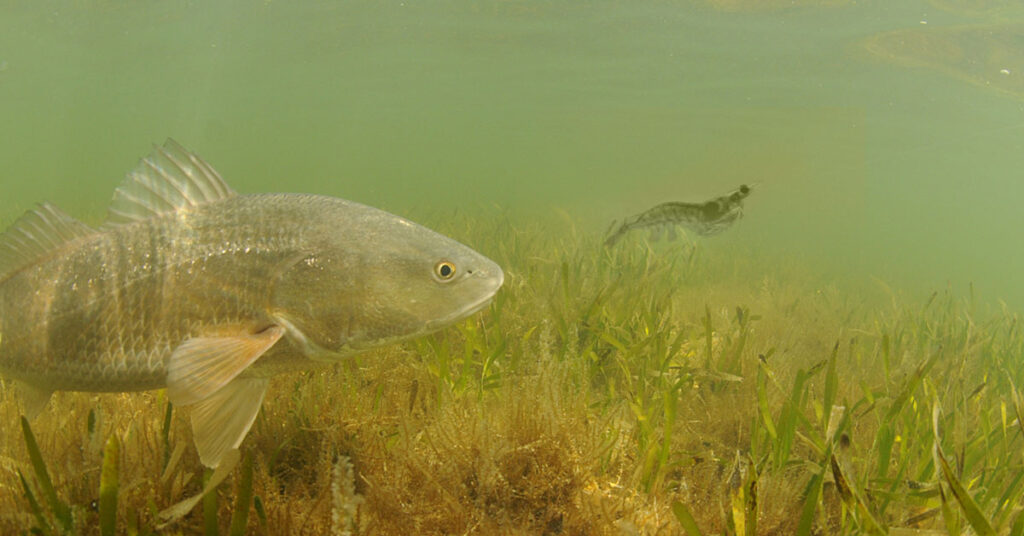Redfish, scientifically known as Sciaenops ocellatus, are prized game fish found in the Atlantic Ocean and the Gulf of Mexico. As versatile predators, their diet is influenced by factors such as habitat, age, and prey availability. In this article, we will thoroughly examine the feeding patterns of redfish.
Table of Contents
- Distribution and Habitat
- Feeding Patterns Across Life Stages
- Dietary Components
- Adaptations for Feeding
- Final Thoughts
Distribution and Habitat
Redfish typically inhabit the following environments:
- Estuaries
- Coastal marshes
- Shallow bays
- Tidal creeks
- Oyster reefs
- Mudflats
Their geographical range spans from Massachusetts to the Gulf of Mexico, encompassing the southern Atlantic coast and the entire Gulf Coast.
Feeding Patterns Across Life Stages
As redfish develop, they undergo various life stages, and their diet evolves accordingly.
Young Redfish
Young redfish, also referred to as “rat reds,” predominantly feed on:
- Small crustaceans
- Grass shrimp
- Mysid shrimp
- Amphipods
- Tiny fish
- Killifish
- Silversides
- Insects and zooplankton (during the earliest stages)
Young redfish usually reside in shallow waters, where seagrass beds and oyster reefs provide abundant food sources.
Mature Redfish
As redfish mature, their diet transitions to include larger prey. Adult redfish mainly consume:
- Bigger crustaceans
- Blue crabs
- Stone crabs
- Mud crabs
- Larger fish
- Menhaden
- Mullet
- Pinfish
- Mollusks
- Clams
- Squid
Adult redfish can be found in a variety of habitats, such as deeper waters close to shorelines, channels, and passes.
Dietary Components
As opportunistic predators, redfish consume a wide array of prey, depending on what is available.
Crustaceans
A significant part of a redfish’s diet consists of crustaceans, including:
- Shrimp
- Grass shrimp
- Mysid shrimp
- White shrimp
- Brown shrimp
- Crabs
- Blue crabs
- Stone crabs
- Mud crabs
- Amphipods
Fish
Redfish also prey on various small to medium-sized fish, such as:
- Menhaden
- Mullet
- Pinfish
- Anchovies
- Killifish
- Silversides
Mollusks
Mollusks, while constituting a smaller portion of their diet, still contribute to a redfish’s nutritional intake. They consume:
- Clams
- Squid
- Oysters
- Snails
Adaptations for Feeding
Redfish have developed several adaptations that enable them to efficiently locate and capture their prey:
- Downward-Facing Mouth: The inferior mouth position allows redfish to effectively feed on organisms dwelling on the seafloor, such as crustaceans and mollusks.
- Pharyngeal Teeth: These specialized teeth, situated in the throat, help redfish crush and grind the shells of prey like crabs and mollusks.
- Barbels: Redfish possess small barbels, or whisker-like appendages, on their chin. These sensory organs aid them in detecting prey concealed in the sediment.
- Camouflage: Redfish exhibit countershading, characterized by a darker back and a lighter belly. This coloration enables them to blend into their surroundings, making it easier to ambush prey.
Wrapping up
Redfish are opportunistic predators with a diverse diet that includes crustaceans, fish, and mollusks. Their feeding habits change as they mature, with adults primarily targeting larger prey. Various adaptations, such as their downward-facing mouth, pharyngeal teeth, and camouflage, allow them to effectively locate and capture prey in their native habitats. Gaining insight into the diet and feeding habits of redfish is essential for anglers and conservationists, as it offers valuable information about the species’ biology, ecology, and role within the ecosystem.
- Family-Friendly Fishing Activities in Carolina Beach - May 21, 2023
- Carolina Beach King Mackerel Fishing - May 7, 2023
- Local Carolina Beach Fishing Reports #523 - May 7, 2023

